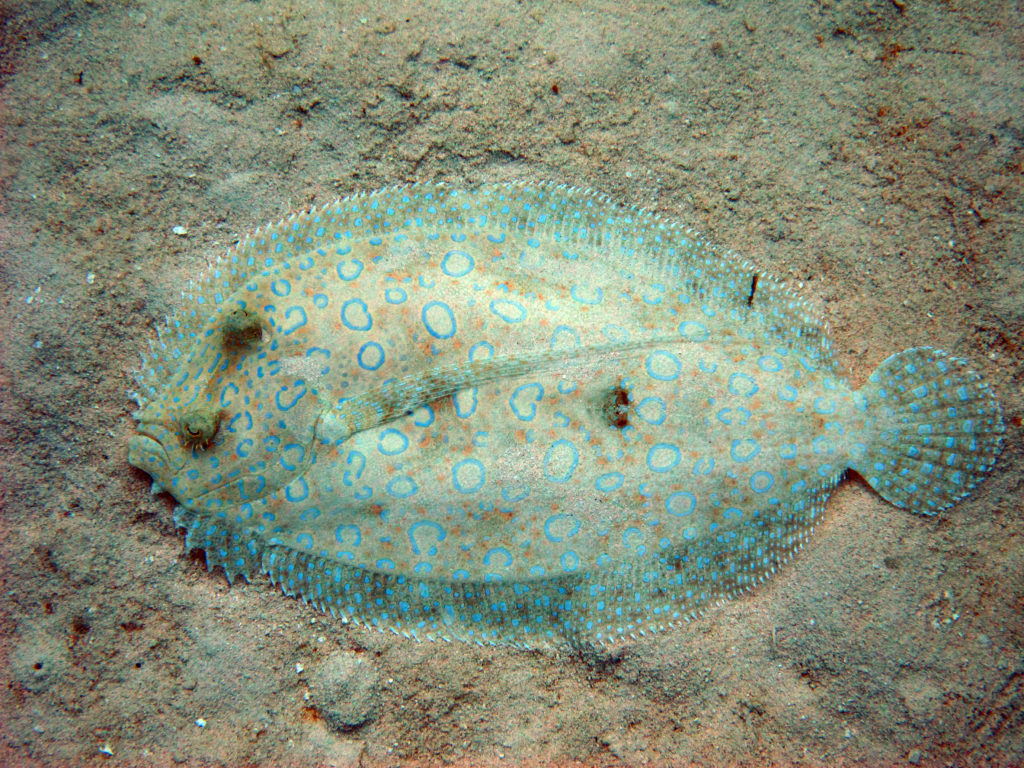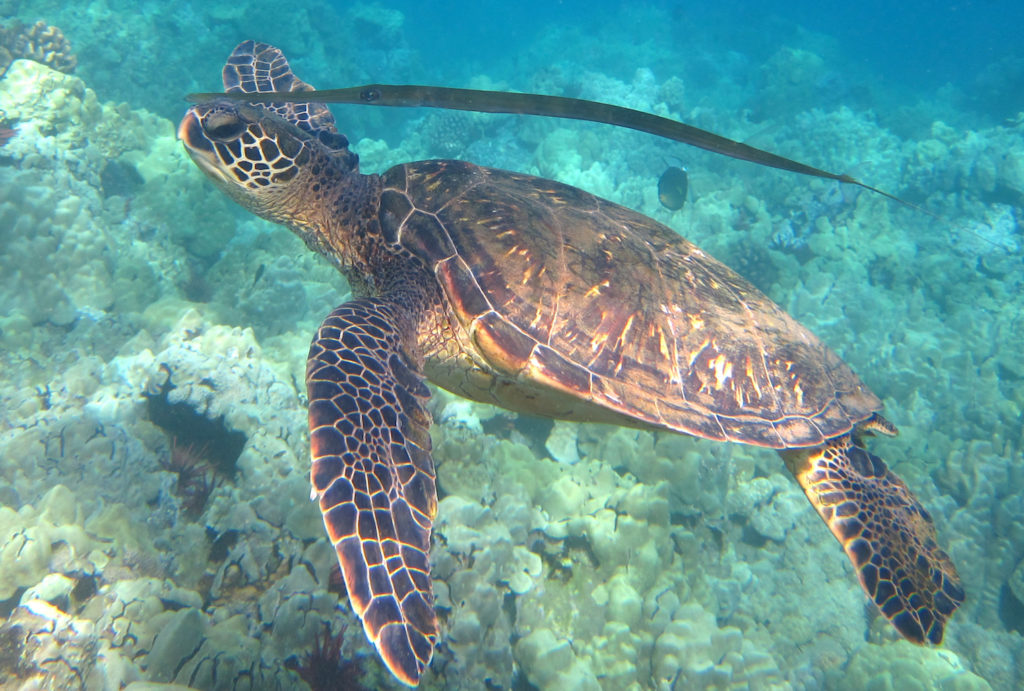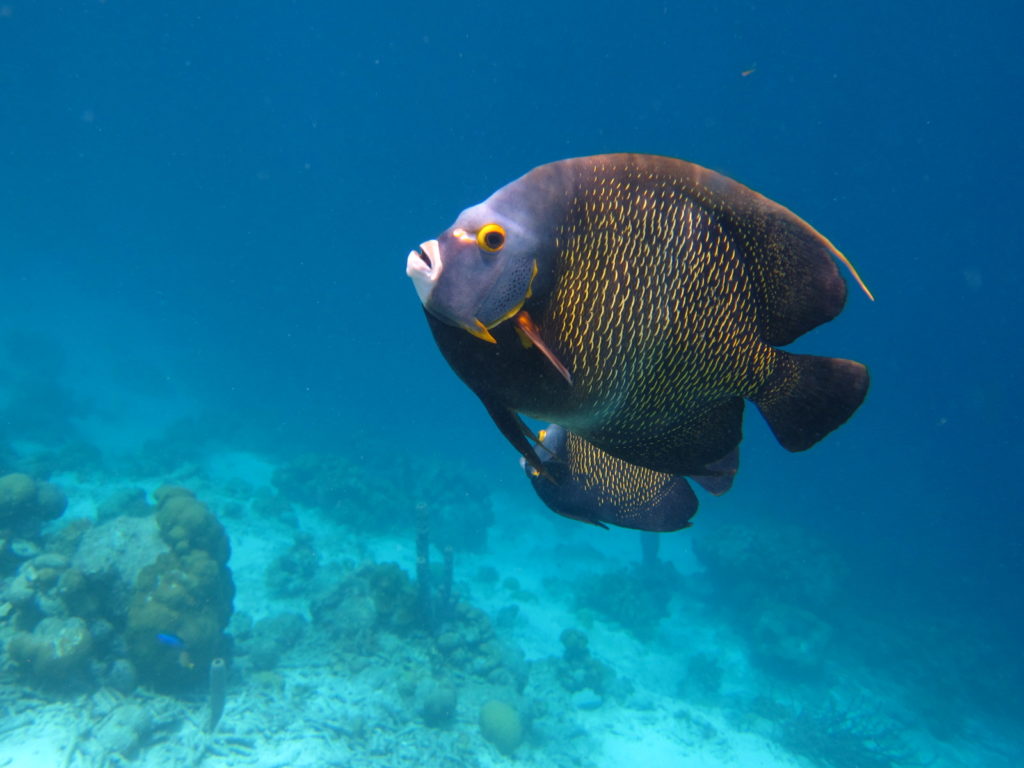Fish, glorious fish. They’re colorful, fanciful, and fascinating. They’re also endangered. Over 600 species of fish are in danger of going extinct. We need to save the fish. The biggest reasons fish species are suffering? Human pollution is harming their habitat, climate change is altering the ocean, and overfishing is hurting some species.
My friend, Sue Langston, has dedicated her life to protecting the environment and advocating for eco-friendly changes in America. An environmental policy maker by day, she travels the world counting fish whenever she can. She takes amazing fish photos from deep under the water. There’s an entire world down there.
Sue says there are five simple things we can all do to save the fish. I’m going to tell you what they are in a moment. But first I have to introduce you to some of the most breathtaking fish in the world’s waters. Once you see these amazing fish photos and admire these beautiful creatures, you’ll feel even more motivated, I hope, to save the fish.
Peacock flounders lie in wait for their prey

The first of the amazing fish photos: Mature peacock flounder, like this one, has both eyes on the same side of its head, allowing it to spot prey while covered in sand. Photo by Sue Langston.
Flounders are predators. But they don’t go out and hunt down their meals. They lie in wait for unsuspecting prey. Their favorite activity is to lie completely covered in sand, with nothing but their eyes showing. There they wait for a small fish or other tasty something to swim by.
Juvenile flounders look more like a normal fish, with an upright body and eyes on either side of their heads. But as the peacock flounder grows up, one eye migrates to the other side of its head so the fish can lie flat on the ocean floor and easily cover itself with sand or mud.
The adult peacock flounder in the first of our amazing fish photos above lives in the waters of the Mexican Caribbean. As you can see, both its eyes are on the same side of his head. Weird, huh?
Tomtate vie to get their teeth cleaned by a Spanish hogfish

The second of these amazing fish photos: Spanish hogfish enjoy cleaning the teeth of these two tomtate grunts. Photo by Sue Langston.
It seems ironic that things in the water still need cleaning. But they do. Fish can get parasites in their mouths or in the blood-rich area around their gills. So some fish have adapted to clean up the parasites (which they eat—tasty!) from other fish. This is an example of “mutualism,” a relationship between two species where both species benefit. The second of our amazing fish photos was taken in the Dominican Republic. The small purple and yellow Spanish hogfish you see in it is a cleaner fish. The white and yellow tomtates with their jaws open wide are begging for a cleaning. They’re both trying to get the Spanish hogfish to clean their mouths and gills.
There are many kinds of cleaners in the ocean: some are just cleaners when they’re small, others take it up as a lifestyle. Some shrimp use cleaning fish as their main source of food. Kind of cool.
Cleaning stations
Places where cleaner species set up shop are called “cleaning stations.” Another interesting factoid: research shows that wounded fish will frequent cleaning stations more often than healthy ones, and there’s evidence that cleaning stations aid in healing and recovery, as well as keeping fish healthy.
Predation is reduced around cleaning stations. Who knew? Fish seem to have an inhibition against eating each other in these areas. Scientists aren’t sure why. But they think it may be to avoid mistakenly eating the helpful fish that clean them.
A spotjaw blenny waits patiently for food to swim by

The third of our amazing fish photos: A spotjaw blenny peeks its head out of coral in the waters near Nicaragua. Photo by Sue Langston.
Blennies are adorable. Most species are very small—the spotjaw blenny’s head in the photo above is not much larger than the tip of your pinkie finger.
These blennies live in small holes in coral or sponges. They often hang out with only their head showing.
Blennies will come out to eat if they see something yummy, as long as its smaller than they are, swimming by.
Green sea turtles have cornetfish hitchhikers

The fourth of the amazing fish photos: An adult green sea turtle swims with a cornetfish in Hawaii. Photo by Sue Langston.
Adult green sea turtles, like the one in the photograph below, eat seaweed and seagrass almost exclusively. So small fish don’t usually hide when sea turtles swim by. Which is exactly what the long, thin, cornetfish in the photo above is counting on. The cornetfish is using the turtle as a shield, so it can pounce on an unsuspecting smaller fish and eat it.
This cornetfish green sea turtle swim-along is an example of “commensalism,” a symbiotic relationship where one species benefits from the relationship, and the other is unaffected by it. Scientists believe that the cornetfish is benefitting from hiding behind the turtle, while the turtle is not affected.
French angelfish

The fifth of these amazing fish photos: French angelfish from Bonaire. Photo by Sue Langston.
Angelfish have thin, plate-shaped bodies. As juveniles, angelfish work as cleaner fish and eat parasites off other fish. As adults, they eat sponges, algae, small jellyfish, and small fish.
Scientists believe that French angelfish mate for life. Angelfish pairs are territorial and help each other defend their territory.
Copper rockfish

The sixth and last of our amazing fish photos: A copper rockfish swims in the cold waters of the Pacific Northwest. Photo by Sue Langston.
It’s cold and murky in the waters of the Pacific Northwest. It’s much harder to count fish there than in more tropical waters where the fish in the other amazing fish photos live.
This yellowish creature in the greenish water with the Dr. Seuss-ish face is a copper rockfish. These fish typically live close to the bottom of the ocean in shallow rocky areas.
Copper rockfish don’t venture far from home. They give birth to live young after a gestation of ten months.
Amazing fish photos, inspiration to care about the oceans and the fish
Here are five simple ways to save the fish and make the ocean a cleaner, safer place for marine life:
1. Stop using single-use plastic.
Plastic invariably ends up in the ocean. It harms the fish and other marine life. Substitute awesome reusable wear for awful throw-away plastic. Carry a metal spoon in your pocket or your purse so you never use a plastic one again. Say no, thank you to “disposable” (it’s not disposable, where does it go?) straws. Go straw-free or use a metal or glass straw instead.Substitute cloth diapers for plastic ones, cloth bags for plastic bags, and metal water bottles for single-use plastic water bottles. If you do use plastic, always dispose of it properly. Don’t litter. Ever. And if you see plastic litter on the sidewalks or the beaches, clean it up!
2. Be careful what you put down the drain.
Everything that goes down the drain winds up in streams. You can’t take amazing fish photos if the fish are all dead. So if you live inland, freshwater fish will be affected by everything you flush. The streams and rivers also eventually drain to the ocean. So try not to put anything toxic down the drain.
What does that mean? Make your own cleaning products out of vinegar, baking soda, and essential oils. Make your own non-toxic laundry detergent out of ingredients that won’t hurt marine life. And skip the shampoo. Say what? Here’s the thing: You don’t need to use shampoo or conditioner. It will take your hair a few weeks to adjust but once it does, you won’t miss it! If you must use shampoo, buy a natural brand with as few ingredients as possible.
Also be sure to never flush pharmaceutical or recreational drugs or any kind of poisons down the drain. Call your local garbage company or city manager to find out how to dispose of them properly.
3. Become a vegetarian or reduce your meat intake to once a week. Eat only sustainable seafood.
When researchers from Canada and Sweden analyzed what actions individuals can take to reduce their carbon footprint they found that four things made a huge difference: having only one child (or fewer), living without a car, avoiding airplane travel, and eating a plant-based diet.
Reducing carbon emissions helps save the fish. A lot of people who don’t eat much meat do eat fish. Fish is delicious and very healthy, especially when it’s low on the food chain and not contaminated with mercury. Fish is a staple in some of the Blue Zones (regions of the world where humans live the longest healthiest lives.)
But being a vegetarian or reducing your meat consumption generates less pollution. In fact, by eating fish less often we can also reduce overfishing. When you do eat fish, choose sustainable fish only. Ocean-friendly choices vary by state. The best recommendations to save the fish in Oregon can be found here. Monterey Bay Aquarium offers printable state-by-state guides.
4. Volunteer for Washed Ashore.
Washed Ashore is a project that makes art to save the seas. This wonderful nonprofit, based in Bandon, Oregon, takes plastic pollution and makes it into sea-saving art.
They make sculptures that are as gorgeous and inspiring as our amazing fish photos. But unlike a photograph, it takes hundreds of volunteers to make just one larger-than-life sculpture. You don’t need to have any art experience to volunteer, you just have to be willing to save the fish.
5. Join REEF.org.
This is Sue’s favorite non-profit organization that helps save fish. REEF is a marine conservation organization that trains volunteers to count fish species and hosts hands-on programs to inspire local communities to care about the oceans and marine life.
Founded in 1990, REEF is based in Key Largo, Florida. Its mission is to protect ocean life and biodiversity by actively engaging people with citizen science, education, and partnerships with the scientific community.
Have these amazing fish photos and inspiring ideas done the trick? What are you going to do today to help save the fish?
18 Ways to be Eco-Friendly in 2018
Plastic Nation No More
A Bucket in Your Bathroom
Wild Places: The Hippos of Ayorou
Last update: September 12, 2022
These photos are gorgeous. I’ve been on my friends and family to cut down on meat consumption and only eat sustainable and wild-caught fish. I’ll be sharing this article with them. Maybe something good will come of it! Fingers crossed.